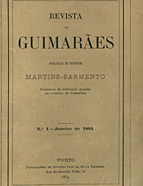

................................
The following decade saw a further decline in the number of new articles (25), probably due to the ageing and death of some of the founders and older contributors. Between 1914 and 1923, the criticism of sources shared prevalence with the emphasis on the history of intellectuals, with both appearing on 6 occasions each. From 1913 until 1920, the Revista de Guimarães was suspended, partly because of the death of the two personalities mentioned (not forgetting the anti-republican stance of the Martins Sarmento Society and the conflict between its leaders and the Guimarães City Council as early as 1910), but it returned in 1921 for a new phase with a volume of new articles never achieved before, registering 32 in that first year under the direction of Eduardo de Almeida, who gave the publication new momentum. In the fourth decade of its existence, the Guimarães' periodical only published articles in the final three years (1921-1923), corresponding to 12 issues, totalling 61 works. In the decade 1924-1933, 78 articles were published. Between 1934 and 1943, the number of articles increased (82). In the following decade, the number of new studies continued to grow. Between 1954 and 1963, the growth in new articles (167) and the prominence of archaeology as a dominant field of study were significantly reinforced. In the following decade, the number of articles dropped considerably. Between 1974 and 1983, the new political regime that began on 25 April of that year consolidated its democratic nature. In the following decade, Portugal joined the EEC. On the other hand, in 1990, the year of the 100th issue of the Revista de Guimarães, a special issue was published, entirely dedicated to Martins Sarmento ( Revista de Guimarães , 1990). In addition, in 1992, a colloquium organised by the Guimarães association was published, dedicated in its entirety to two contemporary thinkers, Antero de Quental and Alberto Sampaio. Between 1994 and 2000, archaeology regained its preponderance in the Revista de Guimarães . The final three volumes published (117 to 119) correspond to the years 2007, 2008, and 2009. It is worth highlighting the participation of Amado Mendes, António Amaro das Neves, Ramiro Pimenta, and Helena Pinto. From a historiographical point of view, the Revista de Guimarães shares a deep connection to the Martins Sarmento Society. Throughout its existence, the periodical consistently published texts by the archaeologist from Guimarães, including a special issue dedicated to him in 1900, the year following his death. The other special and extraordinary issue, published in 1940, was dedicated to commemorating the centenaries of the formation of Portugal and the restoration of independence. From the point of view of the dominant historiographical trends in the Revista de Guimarães, it should be emphasised that between 1884 and 1910, broadly speaking, the erudite vocation was the majority, oscillating between antiquarianism and criticism of sources.
This work is financed by national funds through FCT - Foundation for Science and Technology, I.P, in the scope of the projects UIDB/04311/2020 and UIDP/04311/2020.
